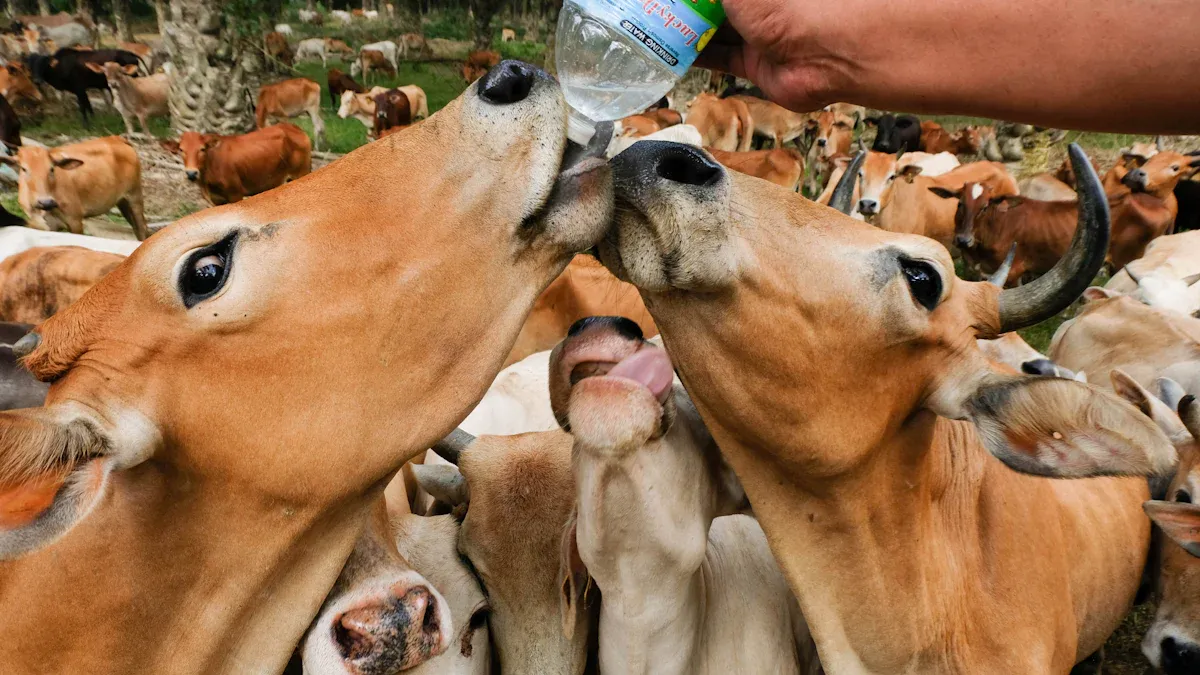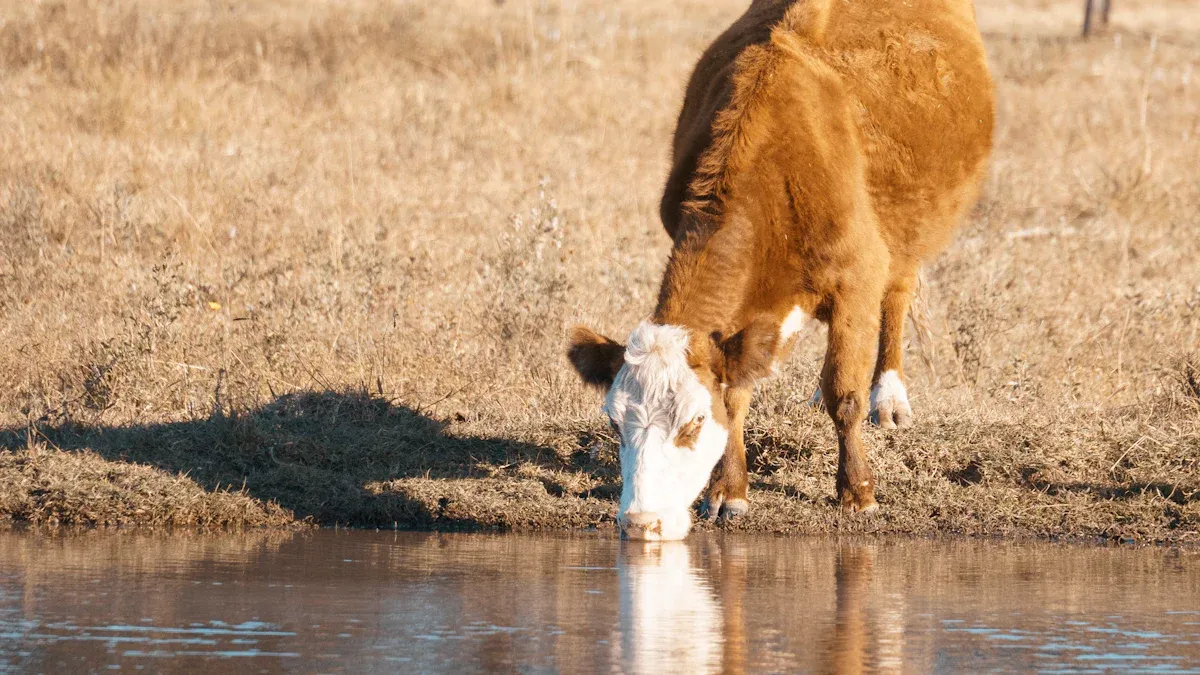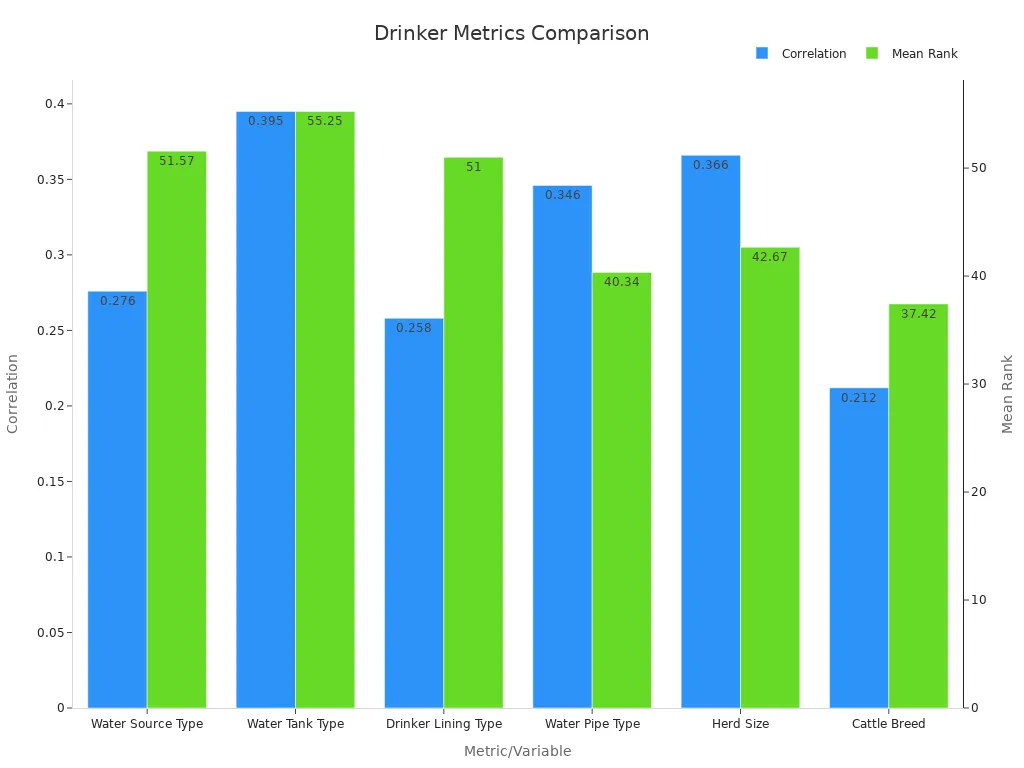
Efficient drinkers play a vital role on cattle farms. They help conserve water and lower operating costs. Farmers who choose advanced livestock watering solutions often notice healthier herds. Reliable systems also reduce spillage and evaporation. These benefits support sustainable farm management.
Key Takeaways
- Using efficient drinkers like automatic waterers and float-controlled troughs helps save water, reduce waste, and keep cattle healthy.
- Proper installation and regular maintenance of drinkers prevent leaks and contamination, saving thousands of gallons of water each year.
- Modern technology such as IoT sensors and smart meters allows farmers to monitor water use in real time, improving efficiency and lowering costs.
Livestock Watering Solutions for Reducing Water Waste

Types of Efficient Drinkers for Cattle Farms
Cattle farms rely on a variety of drinker types to deliver water efficiently. Automatic waterers, float-controlled troughs, and energy-free drinkers each offer unique benefits. Automatic waterers use sensors or valves to refill water as needed, reducing manual labor and ensuring a constant supply. Float-controlled troughs maintain a set water level, preventing overflow and minimizing waste. Energy-free drinkers use animal pressure to release water, making them ideal for remote locations without electricity.
Farmers often select drinkers based on herd size, climate, and infrastructure. For example, large herds benefit from multiple automatic waterers placed throughout the pasture. Smaller operations may prefer float-controlled troughs for their simplicity and reliability. Energy-free drinkers suit farms in colder climates, as they help prevent freezing and reduce maintenance needs.
Tip: Choosing the right drinker type can improve water access and reduce waste, supporting both animal health and farm sustainability.
How Efficient Drinkers Minimize Spillage and Evaporation
Efficient drinkers play a crucial role in reducing water loss from spillage and evaporation. Properly designed drinkers feature splash guards, covered basins, and controlled flow rates. These features keep water inside the trough and limit exposure to sun and wind, which can cause evaporation.
Comparative studies on cattle in different grazing systems show that integrated crop-livestock and crop-livestock-forestry systems improve water productivity and feed conversion efficiency. These systems often use advanced livestock watering solutions that provide thermal comfort and reduce unnecessary water loss. By maintaining cooler water temperatures and reducing direct sunlight exposure, efficient drinkers help cattle stay hydrated and healthy.
A table below summarizes water conservation strategies from various field studies:
| Water Conservation Strategy | Study Setting | Methodology & Data Collected | Key Findings |
|---|---|---|---|
| Weather-Sensitive Irrigation Controller Switches (WSICS) | Municipal athletic fields, Ipswich, MA | Controlled experiments; water meters; weather data simulation | Significant reduction in water use, especially in high-demand settings |
| Rainwater Harvesting Systems | Residential properties, Wilmington, MA | Rainwater tanks; water use measurement; surveys | Rainwater substituted for domestic water, but total use unchanged |
| Outreach Programs (audits/retrofits and rebates) | Residential households | Audits, retrofits, rebates for low-water appliances | Significant water savings achieved |
| Soil Amendments for Moisture Retention | Municipal athletic field | Modeling for moisture retention | Potential water savings without harming turf health |
These findings highlight the importance of using efficient livestock watering solutions to minimize waste and maximize resource use.
Selecting the Best Drinker for Your Herd Size and Needs
Selecting the right drinker depends on several factors, including herd size, water source, and farm layout. Larger herds require robust systems that can deliver high volumes of clean water quickly. Farms with smaller herds may focus on simplicity and ease of maintenance.
A recent analysis of drinker selection metrics provides valuable insights:

The chart above shows how variables like water source type, tank material, and herd size correlate with feed efficiency and water use. For example, plastic-lined tanks and pipes improve water hygiene, supporting better feed conversion. Large herds benefit from multiple water points and advanced cooling strategies, such as shade and sprinklers, to maintain animal welfare.
Key considerations for choosing livestock watering solutions include:
- Herd size and daily water demand
- Water source quality and accessibility
- Tank and pipe materials for hygiene and durability
- Placement of drinkers to ensure easy access for all animals
- Integration of technology for real-time monitoring and leak detection
Note: Farms that invest in tailored livestock watering solutions often see improvements in feed efficiency, animal health, and overall water conservation.
Maximizing Efficiency with Installation, Maintenance, and Monitoring
Best Practices for Installing and Placing Drinkers
Farmers achieve optimal water savings by following best practices during installation. They bury water lines below the frost line to prevent freezing and ensure year-round operation. Strategic placement along fence lines allows easy access for cattle and simplifies maintenance. Proper sizing of drinkers prevents competition and guarantees all animals have access. Insulation and heating devices maintain water temperature in cold climates. Durable materials like HDPE pipes and looped layouts reduce leaks and pressure loss. Farmers who install float valves and automatic shut-off devices can reduce water waste by up to 25%.
Maintenance Routines to Prevent Leaks and Contamination
Routine inspections and cleaning keep drinkers in top condition. Regular maintenance prevents leaks and contamination, which can waste thousands of gallons each year. The table below highlights the impact of maintenance:
| Statistic Description | Data |
|---|---|
| Annual water wasted per family due to leaks | Up to 9,400 gallons |
| Water wasted by poorly maintained irrigation systems | Up to 25,000 gallons annually |
| Water use reduction by well-managed systems | 15% (about 7,600 gallons annually) |
Advanced leak detection methods using artificial intelligence help farmers identify issues early, achieving high accuracy and reducing waste.
Monitoring Water Use with Technology
Modern farms use digital water solutions to monitor systems in real time. IoT sensors, smart meters, and automated alerts track flow, detect leaks, and identify inefficiencies. These technologies provide actionable insights, allowing rapid response and reducing operational costs. Studies show that real-time monitoring leads to improved water conservation and supports sustainable practices.
Ensuring Water Quality While Conserving Water
Intelligent monitoring systems analyze historical data and predict future water quality. Machine learning and IoT networks enable targeted interventions, preventing contamination and conserving water. Monthly sampling detects trends, while high-frequency sampling improves accuracy. These systems help farmers maintain both water quality and efficiency.
Adapting Watering Systems to Seasonal and Environmental Changes
Adaptive strategies such as irrigation scheduling and soil moisture monitoring optimize water use throughout the year. Smart irrigation systems apply water only when needed, reducing waste. Remote sensing technologies provide data for adjusting watering based on environmental changes. These approaches ensure that livestock watering solutions remain effective in all conditions.
Farmers who implement livestock watering solutions and maintain regular monitoring see lasting water savings and healthier cattle. Strategic placement, advanced waterers, and seasonal adaptations all contribute to sustainable operations. Quantitative studies confirm that efficient watering strategies conserve resources and support animal productivity over the long term.
FAQ
What are the main benefits of efficient cattle drinkers?
Efficient drinkers reduce water waste, lower costs, and support cattle health. Farmers also see improved feed conversion and easier herd management.
How often should farmers inspect and clean drinkers?
Farmers should inspect and clean drinkers weekly. Regular maintenance prevents leaks, contamination, and ensures a reliable water supply for cattle.
Can technology help monitor water use on cattle farms?
Yes. IoT sensors and smart meters track water flow, detect leaks, and provide real-time data. These tools help farmers save water and improve efficiency.
Post time: Jun-22-2025
- English
- French
- German
- Portuguese
- Spanish
- Russian
- Japanese
- Korean
- Arabic
- Irish
- Greek
- Turkish
- Italian
- Danish
- Romanian
- Indonesian
- Czech
- Afrikaans
- Swedish
- Polish
- Basque
- Catalan
- Esperanto
- Hindi
- Lao
- Albanian
- Amharic
- Armenian
- Azerbaijani
- Belarusian
- Bengali
- Bosnian
- Bulgarian
- Cebuano
- Chichewa
- Corsican
- Croatian
- Dutch
- Estonian
- Filipino
- Finnish
- Frisian
- Galician
- Georgian
- Gujarati
- Haitian
- Hausa
- Hawaiian
- Hebrew
- Hmong
- Hungarian
- Icelandic
- Igbo
- Javanese
- Kannada
- Kazakh
- Khmer
- Kurdish
- Kyrgyz
- Latin
- Latvian
- Lithuanian
- Luxembou..
- Macedonian
- Malagasy
- Malay
- Malayalam
- Maltese
- Maori
- Marathi
- Mongolian
- Burmese
- Nepali
- Norwegian
- Pashto
- Persian
- Punjabi
- Serbian
- Sesotho
- Sinhala
- Slovak
- Slovenian
- Somali
- Samoan
- Scots Gaelic
- Shona
- Sindhi
- Sundanese
- Swahili
- Tajik
- Tamil
- Telugu
- Thai
- Ukrainian
- Urdu
- Uzbek
- Vietnamese
- Welsh
- Xhosa
- Yiddish
- Yoruba
- Zulu
- Kinyarwanda
- Tatar
- Oriya
- Turkmen
- Uyghur
